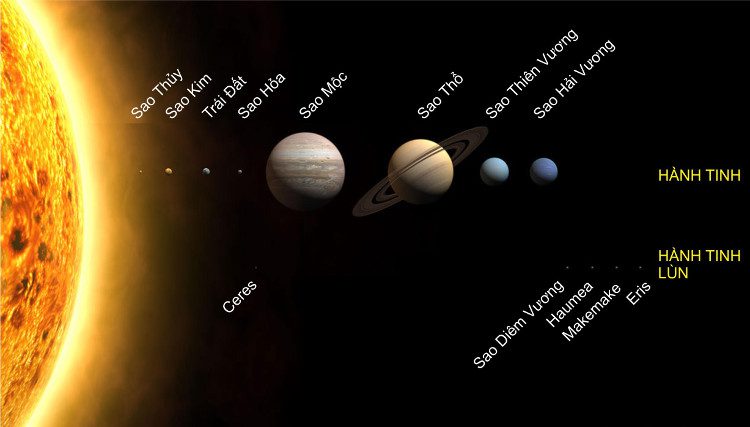The Earth and its neighboring planets, along with asteroids, dwarf planets, meteoroids, comets, and other celestial bodies, comprise the Solar System, with the Sun at its center. Astronomers use a unit of measurement to quantify distances between celestial objects in the Solar System, referred to as AU (Astronomical Unit), or in Vietnamese, Đơn vị Thiên văn.
The distance from Earth to the Sun is 149,597,870,700 meters (149.6 million km).
An astronomical unit (AU) is defined as the distance from Earth to the Sun. One astronomical unit is equivalent to the distance from Earth to the Sun, which is 149,597,870,700 meters (149.6 million km). Astronomers use this unit to measure distances between celestial bodies in the Solar System. For example, the distance from the Sun to Jupiter is 5.2 AU, while Neptune is located 30.07 AU from the Sun.
At the outer edge of the Solar System lies the Oort Cloud, believed to be the birthplace of comets, located approximately 100,000 AU from the Sun. The distance to the nearest star, Proxima Centauri, is around 250,000 AU. However, for measuring even greater distances, astronomers use light-years, which represent the distance that light travels in one year from Earth—equivalent to 63,239 AU. Therefore, Proxima Centauri is approximately 4.2 light-years away from the Sun.
Elliptical Orbits
As you may know, the Earth’s orbit around the Sun is not a perfect circle; it is elliptical. This means that throughout the year, there are times when the Earth is closer to the Sun and times when it is farther away.
The point in the orbit where the Earth is closest to the Sun is called the perihelion, with a distance of about 146 million kilometers, which occurs in January each year. The point in the orbit where the Earth is farthest from the Sun is known as the aphelion, with a distance of about 152 million kilometers, occurring in July each year.

An astronomical unit (AU) is the distance from Earth to the Sun.
Measuring Distances
Historically, the Greek astronomer and mathematician Aristarchus of Samos was the first to measure the distance from Earth to the Sun around 250 BC. In modern times, the Dutch astronomer Christiaan Huygens measured this distance in 1653.
Huygens used the phases of Venus to find angles in the triangle formed by Venus, Earth, and the Sun. For instance, when Venus appeared half-illuminated by the Sun, the three celestial bodies formed an equilateral triangle as viewed from Earth. By estimating the size of Venus (somewhat coincidentally but accurately), Huygens was able to determine the distance from Venus to Earth, and with that distance and the angles of the triangle, he could calculate the distance to the Sun. However, because Huygens’ method was partly speculative and not entirely grounded in scientific evidence, it was not fully trusted.
In 1672, the Italian mathematician and astronomer Giovanni Cassini employed a method involving parallax, or angular measurement, to find the distance to Mars and simultaneously calculate the distance to the Sun. He sent a colleague, Jean Richer, to French Guiana while he remained in Paris. They measured Mars’ position relative to other stars and triangulated these measurements with the known distance between Paris and Guiana. Once they established the distance to Mars, they were also able to calculate the distance to the Sun. Cassini’s methods were considered more scientific and thus more reliable.
New Equations
With the advent of spacecraft and radar technology, humans have acquired direct methods for measuring the distance between Earth and the Sun. The definition of the astronomical unit (AU) was once “the radius of a circular, unperturbed orbit around the Sun of a particle with negligible mass, moving with an average motion of 0.01720209895 radians per day (known as the Gaussian constant).”
This definition, while technically accurate, complicates matters unnecessarily for astronomy professors and does not align well with the general theory of relativity. Using the old definition, the value of AU would vary based on the observer’s location within the Solar System. For example, if an observer on Jupiter used the old definition to calculate the distance between Earth and the Sun, the result would be off by about 1,000 meters compared to calculations made from Earth.
Furthermore, the Gaussian constant depends on the mass of the Sun, and as the Sun gradually loses mass as it emits energy, the value of AU changes accordingly.
In August 2012, the International Astronomical Union (IAU) officially confirmed the figure of 149,597,870,700 meters for each Astronomical Unit. This number is based on the speed of light, a defined distance. One meter is defined as the distance that light travels in a vacuum in 1/299,792,458 of a second.





















































